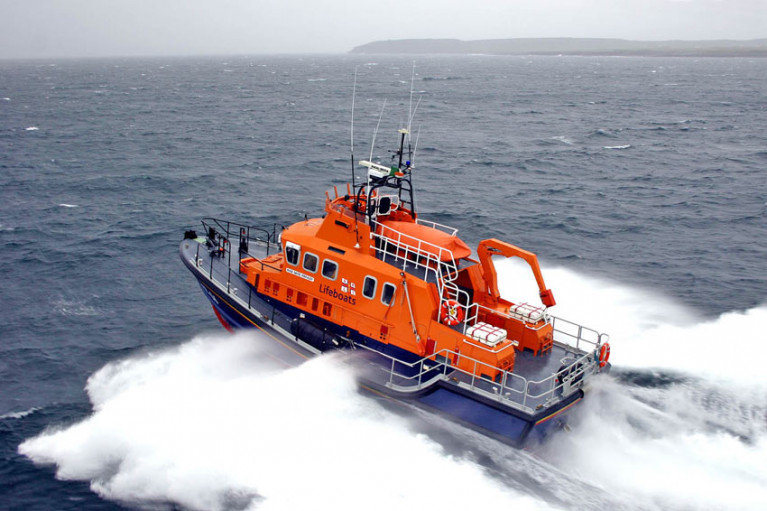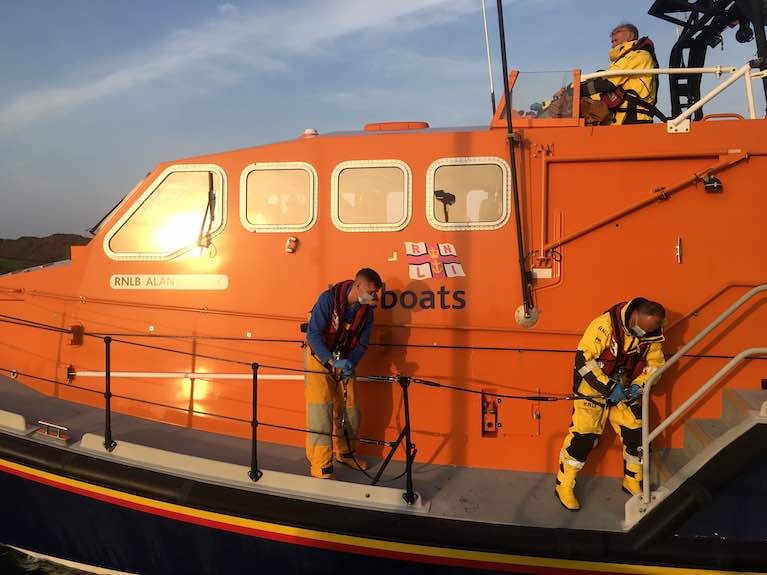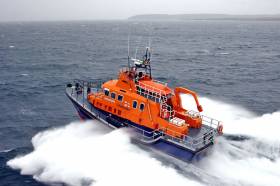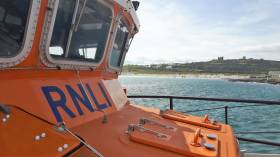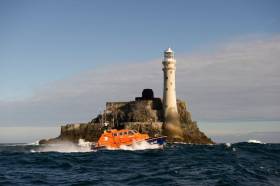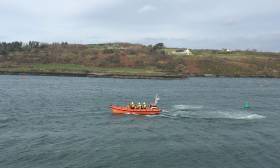Displaying items by tag: Medevac
Double Lifeboat Callout For Medevacs From Aran Islands
Aran Islands RNLI’s volunteers were called twice in succession to aid two people in need of medical attention in the Galway Bay islands yesterday morning, Monday 19 October.
The lifeboat crew were tasked to launch their all-weather vessel David Kirkaldy from Kilronan on Inis Mór at 11.31am, to assist an elderly man on the neighbouring island of Inis Meáin.
A second call came in quick succession when a woman on Inis Mór also required medical evacuation.
This second patient was attended to first and safely secured on board before the lifeboat launched for Inis Meáin under coxswain John O’Donnell and a full crew.
Weather conditions at the time of launching were moderate with poor visibility, but with calm seas and a south-east wind blowing Force 4–5.
Once alongside the pier at Inis Meáin, the male patient was transferred safely aboard and under the supervision of the volunteer crew, observing all coronavirus safety guidelines.
The lifeboat then headed straight for Rossaveal Harbour on the mainland and an awaiting ambulance.
Speaking later, O’Donnell said: “A double callout to start the week — the volunteer crew members train regularly to make the minutes count and get to the incident and patient as fast as possible.
“We would like to wish both patients a speedy recovery.
“Never hesitate to call 999 or 112 if you see someone in trouble and ask for the coastguard.”
Baltimore RNLI Provides Third Medical Evacuation Within 48 hours
Baltimore RNLI was called out to provide a medical evacuation early yesterday afternoon (Monday, 21 September) from Sherkin Island off the coast of Baltimore, West Cork.
The volunteer lifeboat crew launched their all-weather lifeboat at 2.07 pm, following a request from the Irish Coast Guard to provide a medical evacuation (Medivac) to an injured female.
The Baltimore all-weather lifeboat arrived at Sherkin Island at 2.20 pm. The lifeboat crew brought the casualty onboard the lifeboat and they departed the island at 2.30 pm. The lifeboat arrived back to Baltimore Lifeboat Station at 2.45 pm where the casualty was handed over to the care of the HSE ambulance crew.
There were five crew onboard the lifeboat, Coxswain Kieran Cotter, Mechanic Cathal Cottrell and crew members Sean McCarthy, Aidan Bushe and Emma Lupton.
Conditions within the harbour at the time were calm with a westerly force 4 wind and no sea swell.
Speaking following the call out, Kate Callanan, Baltimore RNLI Volunteer Lifeboat Press Officer said: ‘This is the third Medivac for Baltimore within a 48 hour period. Previously there were two Medivacs to Cape Clear Island, the first on Saturday evening and the second on Sunday morning. If you find yourself in need of medical assistance whilst on an island, call 999 or 112.’
Rescue 118 In Long-Range Medevac From Container Ship
Sligo’s Irish Coast Guard helicopter Rescue 118 was tasked yesterday (Friday 28 August) for a medevac from a container ship west of Tory Island.
The Sikorsky S-92 completed the 190-nautical mile round trip to retrieve the sick crewman from the MSC Sao Paulo for treatment on land.
Coastguard In Medevac For Spanish Fisherman On Offshore Trawler
A Spanish fisherman with acute abdominal pain was airlifted from a trawler some 70 miles off Castletownbere earlier this week, as the Irish Examiner reports.
The Irish Coast Guard tasked Shannon-based helicopter Rescue 115 for the medevac on Tuesday afternoon (14 April), which was completed in just over three hours.
It’s understood the ill trawlerman was taken to Cork University Hospital for treatment.
Two Medical Evacuations For Aran Islands Lifeboat On Wednesday
Two people were evacuated from the Aran Islands for medical reasons by the area’s RNLI lifeboat yesterday (Wednesday 28 August).
At 4.50pm the all-weather lifeboat David Kirkaldy called to launch from Inis Mór to neighbouring Inis Meain where an elderly man had been injured in a fall.
Under coxswain John O’Donnell and a full crew onboard, the Severn class lifeboat braved difficulty conditions, with choppy 1.5-metres seas and Force 5-6 west to south-westerly wind, to transfer the casualty to the waiting ambulance in Rossaveal.
Later in the evening, just after 11pm, the volunteer crew were called out for another medevac, this time to a sick man elsewhere on Inis Mór who required further treatment, Aran Islands RNLI says.
Despite the even worse conditions at sea, the man was safely transferred to Rossaveal and the waiting paramedics.
O’Donnell said later: “Yesterday was a busy one for the volunteer crew members but they are always ready to answer the call and happy to help out. We would like to wish both patients a speedy recovery.”
Aran Islands Lifeboat Crew In Medevac Of Injured Tourist
Aran Islands lifeboat volunteers launched their all-weather lifeboat on Saturday afternoon (17 August) to carry out a medical evacuation for an injured tourist.
The female visitor to Inis Mór had sustained a suspected fractured leg while out sightseeing, Aran Islands RNLI said.
The casualty was transferred safely aboard the Severn class lifeboat David Kirkaldy under coxswain Tommy Dirrane and a full crew, and was brought to the waiting ambulance at Rossaveal Harbour.
Dirrane said later: “The volunteer crew members train regularly to maintain their quick response time and that can make all the difference to the casualty you are going to help. We would like to wish the casualty a speedy recovery.”
Elsewhere on Saturday, Rosslare Harbour RNLI volunteers were called to assist a small yacht with two onboard in difficulty off Cahore Point off the North Wexford coast.
Tangled in a lobster pot line and unable to sail in the freshening south westerly wind, the crew called the Irish Coast Guard for assistance, according to the RNLI.
Rosslare Harbour RNLI volunteers launched their all-weather lifeboat and reached the yacht in a short time.
Lifeboat volunteers reached the yacht in short order and set up a tow line to bring it close to Cahore Harbour, where the Cahore inshore rescue boat took over due to the shallow water.
Rosslare Harbour RNLI coxswain Eamonn O’Rourke said: “I would like to commend our volunteer crew who worked hard to attach a tow to the yacht in challenging conditions. We were glad to see the vulnerable yacht and her crew safe.”
Aran Islands RNLI responded to two medical evacuations, or medevacs, yesterday morning (Tuesday 23 July).
The all-weather Severn class lifeboat Margaret, Joan and Fred NYE launched at 10.15am following a request from the Irish Coast Guard, headed initially to Inis Meain.
Weather conditions were good with a 1.5m swell and a force 4-5 southerly wind as coxswain Mairtín O’Flaithearta and a full crew approached the pier at Inis Meain, where a teenager requiring further medical attention was taken aboard the lifeboat.
The crew then proceeded to Inis Oirr, where a young child also requiring further medical attention was taken aboard.
Both casualties were then taken straight to Rossaveal Harbour where they were transferred to hospital for further treatment.
Speaking after the callout, O’Flaithearta said: “A call can come at any time, and often like today where we had get two call outs at once. In situations like this, our regular crew training helps with a quick response time.
“We would like to wish both casualties a speedy recovery.”
The medevac came just days after Aran Islands RNLI were called to assist a yacht with engine difficulty off Straw Island.
Medevac From Cape Clear Island For Baltimore Lifeboat
Baltimore RNLI carried out a medevac last night (Friday 7 June) from Cape Clear Island off the coast of Baltimore in West Cork.
The volunteer crew launched their all-weather lifeboat at 6.20pm, following a request from the Irish Coast Guard to provide medical assistance and evacuation to an islander living on Cape Clear.
The lifeboat arrived at North Harbour in Cape Clear within 20 minutes, and was headed back to the mainland with the casualty on board after just a two-minute turnaround.
By just after 7pm the casualty had been handed over to the care of a HSE ambulance crew in Baltimore.
Conditions at sea during the call out were good, with a north-westerly Force 4-5 wind, a one-metre sea swell and very good visibility.
Speaking following the callout, lifeboat press officer Kate Callanan said: “If you find yourself in a medical emergency whilst on an island call 999 or 112 and explain to the operator what the nature of the call is.
“The operator will then make sure that the call is directed to both the coastguard and the National Ambulance Service. We wish the casualty a full recovery.
“Our thoughts today are also with the family, friends and colleagues of the crew members of the French lifeboat service SNSM who lost their lives yesterday during a rescue.”
There were seven volunteer crew onboard the lifeboat on this callout: coxswain Kieran Cotter, mechanic Cathal Cottrell and crew members Jerry Smith, Kieran Collins, Pat Collins, Colin Rochford and David Ryan. Assisting at the boathouse in Baltimore were Gerald O’Brien, Aidan Bushe and Don O’Donovan.
Baltimore Lifeboat Assists In Medevac From Heir Island
Baltimore RNLI carried out a medical evacuation last night (Wednesday 22 May) from Heir Island off the coast of West Cork.
Baltimore’s volunteer lifeboat crew launched their inshore lifeboat following a request from the Irish Coast Guard at 8.34pm to provide medical assistance and evacuation to a woman on Heir Island who had sustained injuries following a fall.
The inshore lifeboat arrived at the pier on Heir Island at 8.50pm and removed the casualty to the lifeboat station 20 minutes later, where she was handed over to the care of HSE Ambulance crew.
Conditions at sea during the callout were calm with good visibility and no sea swell.
This was the first call for Baltimore’s new Atlantic 85 inshore lifeboat, Rita Daphne Smyth, since she arrived on station last September.
Speaking following the callout, Baltimore RNLI volunteer lifeboat press officer Kate Callanan said: “Baltimore lifeboat is often called upon to safely transport casualties between the islands and mainland, and our volunteer crews are trained in casualty care.
“If you find yourself in need of medical assistance, call 999 or 112 and ask for the coastguard. We wish the casualty a full recovery.”
There were four volunteer crew onboard the lifeboat: helm Jerry Smith and crew members Kieran Collins, Micheal Cottrell and Ian Lynch. Assisting at the boathouse in Baltimore were Rianne Smith, Marty O’Driscoll and Kieran Cotter.
In other lifeboat news, the outgoing chair of Clonallen Bridge Club, Warrenpoint, Maire Murray, chose the RNLI as the charity of choice for the year 2018-19.
At a recent meeting of the Clonallen Bridge Club a cheque for £500 was handed over to John Fisher, Kilkeel RNLI lifeboat operations manager by the club’s incoming president Marius McQue.
Fisher said: “As a charity we are always very thankful for all the money collected and donated to the RNLI. Giving our lifesavers the equipment they need to save lives is very expensive so be assured that the funds raised are used in the best possible way.”
Baltimore Lifeboat In Medical Evacuation From Sherkin Island
#Lifeboats - Baltimore RNLI carried out a medevac on Thursday night (11 April) from Sherkin Island off the coast of West Cork.
The volunteer crew launched their all-weather lifeboat following a request from the Irish Coast Guard at 9.29pm to provide medical assistance and evacuation to an islander living on Sherkin.
Conditions at sea during the callout were calm with good visibility and no sea swell.
The lifeboat arrived at Sherkin pier at 9.45pm, the casualty was brought onboard and the lifeboat departed the island within four minutes, handing the casualty over to the care of HSE ambulance crew at 10.08pm.
Speaking following the callout, Kate Callanan, Baltimore RNLI volunteer lifeboat press officer, said: “Baltimore RNLI regularly provides the vital service of medical evacuations (medevacs) for residents and visitors to local islands such as Sherkin, Cape Clear and Heir.
“If you find yourself in need of medical assistance, call 999 or 112 and ask for the coastguard.”
Elsewhere, volunteer lifeboat crews from the Aran Islands and Galway RNLI participated in a multi-agency training exercise on Galway Bay this week.
The all-weather lifeboat from Aran Islands RNLI and the inshore lifeboat from Galway Bay RNLI were among the many emergency service agencies that took part in a maritime mass rescue exercise.
The scenario training, which saw the lifeboat crew practise an evacuation of survivors from a seagoing ferry in a busy shipping lane, was organised as part of a multi-agency exercise co-ordinated by the Irish Coast Guard.
Among the other agencies involved were the Irish Coast Guard rescue helicopters located at Sligo and Shannon, Doolin/Inisheer Boat Unit, Costello Bay, Killaloe, Kilkee and Cleggan Coast Guard units, Galway Fire Service and the HSE.


























